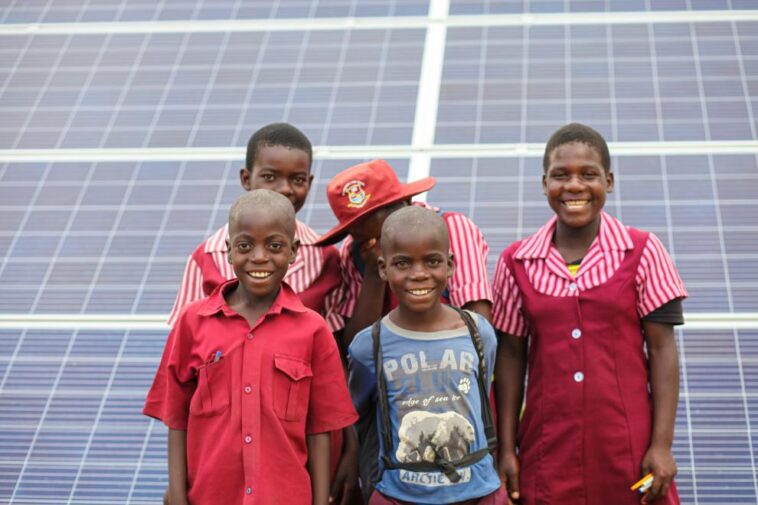By Wendy Nyakurerwa-Matinde
UNICEF has set its sights on ensuring that 150 disadvantaged P3 schools in Manicaland and Matabeleland South Provinces are connected to a 6.5KVA solar system and a wireless access point with a Wi-Fi radius of 300 meters.
The solarisation of schools makes education more flexible. It gives students access to the Learning Passport and other e-learning platforms, equipping them with world-class information communication technology skills in line with the new curriculum.
UNICEF is solarising schools through the Education Development Fund (EDF) TEACH programme, with funding support from the UK Government in partnership with the Ministry of Primary and Secondary Education.
The programme enables learners to access digital learning content for use when they go to school and offline.
This has had an immensely transformative and positive impact on education.
According to the 2022 Population and Housing Census, Zimbabwe’s electricity access rate stood at 62 per cent of the population.
The same report states that 91.1 per cent of households that did not have electricity were in rural areas, compared to 9.9 per cent in urban areas.
Unfortunately, energy poverty reduces education quality, stifling access to teaching and learning materials.
In Manicaland, schools were drawn from Buhera Chipinge and Nyanga, while in Matabeleland South, it was Beitbridge, Matobo and Umzingwane Districts.
Already, 70 schools have been solarised and are awaiting commissioning and certification.
The remaining 80 schools will be by the year’s end.
Following the solarisation of the schools, dependable power has set the foundation for information communication technology in the formerly marginalised schools, and there is hope that the digital divide between rural and urban school children will finally be narrowed.
During interviews with school authorities and students, the excitement is palpable.
Ms Rudo Mwedzi, the Headmistress at Nyarukowa Primary School in Nyanga, could not hide her joy as she explained how her school’s pupils and teachers benefit from the solarisation.
“What is very clear is that solarisation of schools assists staff retention. Before this development, teachers would come and go due to a lack of electricity. This was affecting the smooth flow of lessons. However, ever since the solarisation of our school, staff retention has improved significantly,” said Ms Mwedzi.
Nyarukowa Primary School, like 69 other schools, was connected to a 6.5KVA solar power system in April this year. The system provides power to the school’s administration block, one computer lab with 40 power charging points, and lighting and charging stations in teachers’ houses so that they can work both at school and home.
Ms. Mwedzi said that before the solarisation of her school, their computers were lying idle.
“We are now using computers to type our examinations. We are also printing the examinations here, reducing our costs. Our neighbouring secondary school also benefits as we have allowed them access to the computer lab when preparing for their examinations.
“Our students are also getting practical computer lessons. We are preparing them for the future because almost every job today requires some technical knowledge,” said Ms. Mwedzi.
Mr Paul Gada, a teacher at Nyarukowa Primary School, spoke about the reliability of solar energy.
“Solar energy is reliable. There are no disruptions in our work, and this is increasing the quality of education for our students. We usually mark our students’ assignments at home, so a reliable energy source is of the essence,” said Mr Gada.
A Grade Seven student at the school, Praise Jokiyu, said she now knows how to use a computer since her class gets three weekly practical lessons.
She also said they are not the only beneficiaries of the solarisation program as the local community also charges their phones on the school’s energy kiosk.
Another Grade Seven student from Chidazuru Primary School, Britney Mafara, chipped in: “In our case, we are now doing computer lessons twice a week, and we are excited about this as it allows us to be part of the digital world.
“We have Wi-Fi, and when not in the computer lab, we can connect through smartphones. This assists us in doing our research on the Internet. l believe l am ready for my final exams as l have been accessing so much information online,” said Britney.
Mr Elisha Mafara, the Headmaster for Chidazuru Primary School in Nyanga, said the school’s computer lab and staff houses are now connected to solar, allowing teachers to work anytime.
“The solar project has made our lives more comfortable. We have lighting in our houses, and teachers have ample time to prepare for their lessons. Computers connected to the Internet have a wealth of knowledge that can be accessed anytime. I expect a higher pass rate in this year’s examinations,” said Mr Mafara.
A teacher at the same school, Ms Irene Munyengeterwa, said that before the solarisation of the school, they would charge their gadgets in the community.
“The situation was terrible. Imagine walking long distances to get to the shops or people’s houses to charge our phones. A lot of teaching time was being lost,” she said.
“This program promoted e-learning at our school, and we are now using online educational videos to complement the traditional text-based materials for our classes, and l have noted that the students are engaging with the information more dynamically,” said Ms Munyengeterwa.

